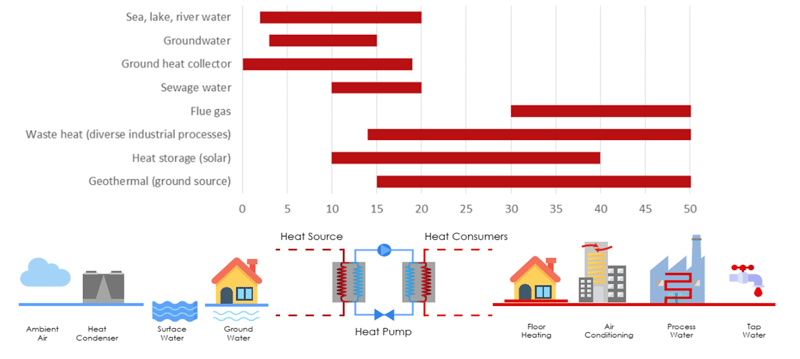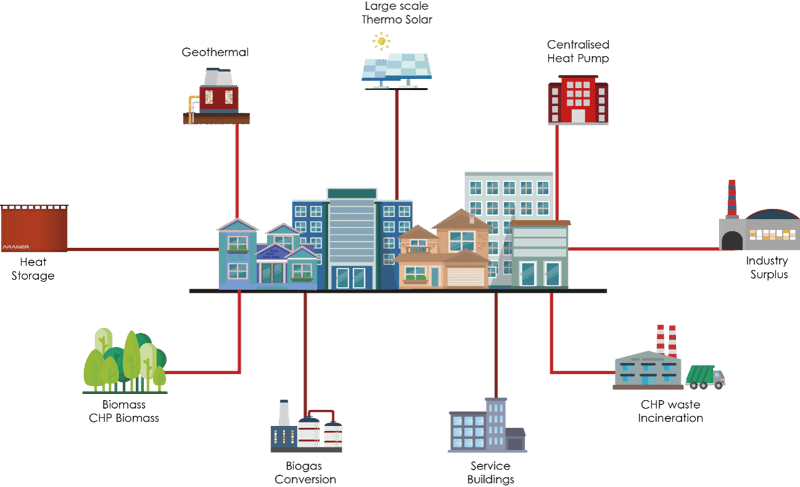The quest to find more sustainable solutions has impacted every industry, and heating technologies are no different. While the central approach to district heating stands out as more environmentally friendly than other alternatives, it’s now crucial to review the multiple possibilities for this heating model in order to build sustainable heating systems.
On the one hand, traditional district heating technologies have relied on burning fossil fuels, including coal, fuel or gas. However, new possibilities have emerged that reduce these systems’ fuel dependency and their CO2 footprint.
As a consequence, district heating and cooling models can meet rising energy demand in urban areas, as well as improve their sustainability by implementing more efficient heating and cooling models.
Buildings and constructions are responsible for nearly 40% of total direct and indirect CO2 emissions (according to the IEA). Thus, minimizing their environmental impact can make a crucial difference in meeting target greenhouse emissions established by the European Union, which has commited to reduce energy consumption by 40% by 2030 and between 80 - 95% by 2050.
However, most district heating models still currently employ fossil fuels, according to stats published by Irena. How can district heating technologies approach more sustainable models and what are the key benefits of developing sustainable heating systems? Keep reading to find out.
Keep reading: District Heating Market Trends and Growth
| Table of contents |
| The main sustainable district heating technologies |
| Benefits of sustainable heating technologies |
| How to pick the right heating technologies for district heating |
The main sustainable district heating technologies
1. Heat Pumps
Large Scale Heat pumps stand out as the main sustainable heating technology for district heating models. Explained briefly, heat pumps work by absorbing heat from a source and delivering it at a sink, using refrigerants compressors
Heat pumps are known to be extremely efficient and sustainable heating technologies. In fact, a well-adjusted and designed heat pump is able to deliver more heat output than the equivalent of the electric input it uses. For instance, from every electric unit consumed, it can deliver between 3 to 6 heating units, as opposed to electrical heating, which might provide one heating unit per one electricity unit. At the same time, these heat output values can go as far as ranges between 250 - 400% more heat than alternative electric resistance heating systems.
There are different types of heat pumps which adjust to their intended use, the most common being domestic and industrial heat pumps. The latter are also known as large scale heat pumps, large capacity heat pumps or high temperature heat pumps.
When considering installing a heat pump in order to obtain sustainable heating systems, a number of possibilities must be taken into account when it comes to heat sources.
Simply put, heat sources are the origin from which heat pumps obtain heat to conduct evaporation processes in refrigerants. As such, different heat sources represent different performance degrees, and must be chosen according to the necessities of each district heating system.
The following heat sources stand out as sustainable heating technologies for large scale or industrial heat pumps:
- Geothermal sources: this technology makes use of underground water’s properties, namely how this element’s temperature remains constant year round. As such, heat pumps can employ geothermal heating sources to capture energy from geothermal wells. Is one of the best options in terms of heat quality.
- Sewage water is considered a renewable heat source as it can be used to recover waste heat for district heating or cooling. It has a high energy potential mainly because the temperature of wastewater is relatively high, typically above 10 °C, which makes it a good source of heating.
- Residual heat from other industries.
- Seawater, river water, uses the same concept to extract heat energy to evaporate the refrigerant. Typically these heat source temperatures are lower than previous options.

2. Combined heat and power plants
Combined heat and power plants employ residual heat from burning fossil fuels in order to obtain energy. Also known as cogeneration, they can both generate electricity and heat, employing energy that would otherwise go to waste.
3. Other solutions
The search for sustainable heating systems has led to the development of a number of other heating technologies that are also being experimented with. Some of the most prominent include:
- Biomass heating technologies: these systems source energy from the burning of natural and renewable resources and living things, such as trees and plants.
- Solar heating technologies: passive systems make the most of a building’s walls, windows and floors to collect sun energy for heating and cooling purposes. On the other hand, active solar heating technologies use solar cells and photovoltaic materials, converting sunlight into electricity.
- Wind-powered heating technologies: these act in a similar way to active solar technologies, harnessing energy from the wind.
- Biodiesel heating technologies: these depend on burning biodiesel, which is more sustainable than fossil fuels as it’s cleaner and renewable.
Benefits of sustainable heating technologies
While incorporating sustainable heating technologies means taking up transformations and an initial investment, these also represent a number of benefits.
First and foremost, sustainable heating technologies such as heat pumps in district heating models are cost-efficient in many respects. They thus provide a guaranteed return on investment because of the following reasons:
- They are not dependent on the constant fluctuations on gas prices. In fact, they originate heat from low-cost, locally-produced and renewable heating sources. At the same time, they contribute to the circular economy, as they promote the use of waste heat (particularly those systems using sewage water or residual industrial heat as a source).
- As they align with current legislation promoting the cutting of CO2 emissions, they can also benefit from economical benefits issued by governments. In fact, these heating technologies reduce GHG emissions, air pollution, acid precipitation and ozone depletion. As such, they align with a reduction on fossil fuel dependence and contribute to the circular economy.
- They optimize the use and storage of heat, minimizing costs, based on use patterns and weather prediction data.
- All in all, it's important to understand sustainable heating systems from a full life cycle analysis perspective. This means adopting a perspective that takes into account the environmental and economical impacts these technologies generate from cradle to grave and incorporates multiple criteria.
It may interest you: Benefits of District Energy: Advantages of Heating & Cooling District
At the same time, heat pump systems can be combined with renewable energies’ models in order to generate an environment of mutually influential heating technologies that add up to guarantee efficiency and economical benefits.
How to pick the right heating technologies for district heating
When choosing among the current possibilities in heating technologies, particularly in the case of large capacity systems, there are a number of criteria that should be taken into account:
- Cost benefits: he seletion of heating technologies must be guided by each project's needs and singularities. This includes the choice of the righ heating source for heat pumps, considering the climatic conditions and other possibilities present at the exact location. Other factors such as carbon regulations, potential taxes, tax-exemptions or funds and electricity costs must also be taken into account following the knowledge and expertise of professionals.
- Efficiency: operational costs and energy use must be optimized through a complete design overview. For instance, in the case of heat pumps, a complete design overview must be taken into consideration in order to find the most suitable refrigerant and the lowest heat pump lift possible.
- Design flexibility: efficiency also comes hand in hand with being able to reduce the necessary space for the system site, as well as the number of units required. At the same time, heating technologies must be picked according to each project’s needs and possibilities, including the available heat sources and footprint.
- Reliability: trustworthy and experienced suppliers must be chosen in order to guarantee correct operating processes as well as minimizing maintenance operations. All major components should be built and inspected according to the most widely recognized international codes.
- Sustainability: Alternatives that involve burning fossil fuels that produce CO2 will not be an option in the long term due to the environmental policies regarding decarbonisation that are being adopted by all countries in the world to achieve a low-emission global economy. Heating technologies must be analyzed from a full life-cycle perspective to ensure a sustainable use of resources that complies with current regulations, as well as to minimize the environmental impact of these systems.
All in all, it’s crucial to rely on trusted experts in developing heating technologies, in order to guarantee the chosen system adjusts to each project and provides a sustainable, cost-effective solution.

Want to learn more about current sustainable heating models and how to apply them to district heating models? Download our free ebook ‘District Heating’ and discover the heating technologies that can be implemented in projects where decarbonization, energy efficiency, sustainability and operational costs are the main design factors.










